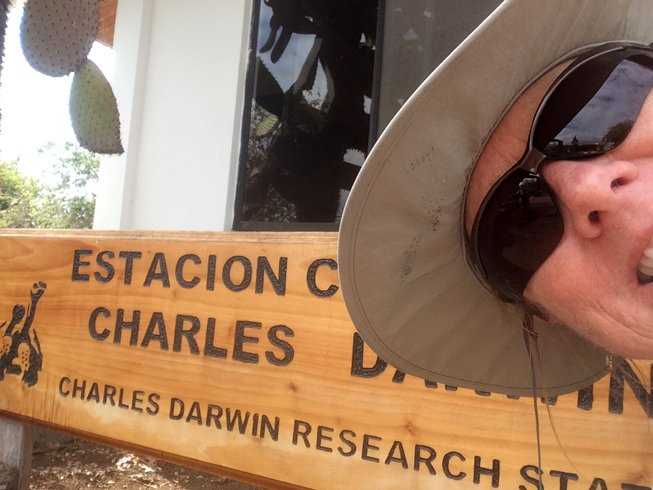The National Geographic Islander pulled into our anchorage in Academy Bay early this morning. Next to us could be seen the buildings and lights of civilization. Wasn’t sure if we were ready for this – but there we were! The wild and pristine national park land is 97% of all terrestrial area in Galapagos, but of the 3% developed and settled by humans, Santa Cruz Island has a big part. Coming here for one day offers us opportunities impossible on uninhabited islands; namely access to the lush highlands, wild giant tortoises, and the tortoise rearing center operated by the Galapagos National Park Service.
The morning was used to learn about the program that rears hatchlings from these endangered giant tortoises, later released into the wilds of their native islands. In some cases eggs are collected from nesting sites out on the islands (time and labor-intensive work), in other cases the remaining breeding adults are so few in number they are kept protected in corrals here and their offspring are carefully looked after until about 5 years of age (or 25 centimeters across the dome). At that point they are returned via boat or helicopter to their island of origin in the hopes they will be fruitful and multiply. By coincidence, a pick-up truck passed us with two crates of these “releasees-to-be” in the back. They were going into quarantine before travelling back to their island of origin (Santiago Island), in order to make sure no seeds of unwanted plants remained in their guts before they leave.
By mid-morning everyone had dispersed as we walked back through town, some to people-watch, some to photograph the fish market, and others to peruse the many shops of town. However by late morning we had gathered to go high…by bus up into the green highlands of Santa Cruz.
Tomas de Berlanga is an alternative school located in the middle of a forest with classrooms that have no glass or screened windows. The school is bilingual and the hope is to create a generation of future leaders for the local community. Because all of this has a price, Lindblad Expeditions – National Geographic in partnership with our guests, provide scholarships for children from families with few resources. A certain level of academic achievement is all that is required to stay.
A group of our guests chose to visit the school instead of the highland farm where the others stopped on the way to lunch. At the farm coffee, sugar cane and their products were seen and tasted! There was also an interesting selection of bananas hanging up for the taking. We are so used to the regular store bananas, it is easy to overlook that many varieties exist world-wide– and equally tasty to boot!
The afternoon was our opportunity to continue by road further into the green highlands in search of the giant tortoise population living here on the island of Santa Cruz, Chelanoides niger. It is surprising that this species has survived as well as it has considering humans moved in full-time beginning of last century. And with people come their cherished domesticated mammals that many times escape and become feral; cats, dogs, pigs and goats are the worst. Cattle, horses and donkeys have slower reproductive cycles and are more easily controlled. There are also the unintentional introductions, too: black rats, Norwegian rats, and house mice. The Galapagos National Park has an entire division dedicated to the eradication of these introduced mammals in order that the endemic vegetation, giant tortoises, land birds, and reptiles which are found no-where else on earth, may survive. We still have so much to learn from them!
By sunset we were all home, but the evening continued with events! Musicians from town and their dancers came to share a bit of local culture with us as well! It was a long, fruitful day with a satisfying end.







